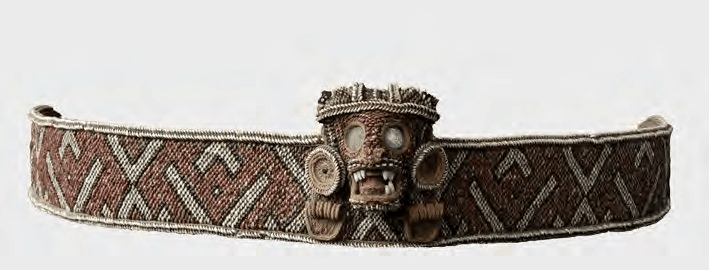
While appreciating some of the brilliant pieces of polychrome ceramics produced in ancient Puerto Rico, included in Mela Pons Alegria's book on Saladoid ceramics, we could not help but notice certain patterns and designs that recur in later Taino art. While some of these similarities may be explained by recurring patterns and geometric designs influenced by hallucinations, others suggest deeply rooted practices and aesthetics that were likely inherited by the later "Taino" civilization. The above piece, a rather remarkable decorative plate with 3 circles, each one with a distinctive central circle within. The circles are organized along a line and each one appears to have what may be legs, perhaps something akin to a frog?

The similar arrangement of 3 circles along a line was a frequent motif in Taino duhos, or stools. While the stools were produced centuries later, the fact that the back often had the similar design of 3 circles is likely significant. Perhaps the 3 circles, representing the Sun, Moon, and horizon, signified the cosmos that was supporting a Taino cacique? The above example, from Hispaniola and reproduced in Arrom's careful study of Taino art and mythology, is one of the best examples of the pinnacle reached by duho sculptures. Other pieces with even more elaborate backs included intricate panel designs with faces. Indeed, the pattern of 3 circles on high-backed duhos can even be seen in stone stools found in Puerto Rico and some of the stools from the Bahamas.

Undoubtedly, the similar designs on duhos from Hispaniola, Puerto Rico and the Bahamas points to some degree of common culture and cultural exchange. In addition, if women were the potters among the Saladoid culture in ancient Puerto Rico as well as the producers of some of these elaborate duhos, as suggested by Pieter Martyr d'Anghiera for the case of Xaragua in Haiti, perhaps female artisans inherited some of the same designs and applied it to a different medium, wood and stone. For instance, one can see stylistic similarities in the faces of anthropomorphic and animal figures in stone trigonolith cemis from Puerto Rico and wooden duhos from Hispaniola. This suggests that the artists of these works were competent with stone, wood and possibly ceramics or pottery. Granted our evidence for women producers of duhos is only available for the inhabitants of La Gonave, but it is suggestive of a possible deeply rooted tradition of circular patterns from pottery adjusted to duhos.

Thus, in our minds, the consistent pattern of 3 circles on high-backed duhos from 3 different island cultures that shared the "mosaic" of Tainoness points to trade and common origins. The pattern of the 3 circles must have held some deep meaning, which the ancient Hacienda Grande decorative plate may have shared. As mentioned previously, it likely had religious relevance and could have been tied to a common cosmovision. We know the Sun was important in the Taino cosmovision, and perhaps the 3 circles symbolized the stars? Alternatively, the Hacienda Grande pot features what may be legs, perhaps an allusion to frogs or another animal associated with life. In addition, the designs might symbolize life if the squatting position are associated with frogs, water, and birth.

The remarkable continuity of motifs and styles across different mediums like pottery, stone and wooden sculpture strongly suggest cultural continuity and exchange in Hispaniola, Puerto Rico and the Bahamas. The deeply rooted Saladoid tradition must have influenced subsequent cultural development, particularly in Puerto Rico and the Dominican Republic. Unfortunately, we have not seen more examples of ceramics and sculpture from the Hacienda Grande and other cultures of Puerto Rico.

Our theory, of course, is pure speculation. But it does suggest some possible antiquity to aesthetic styles found on the ornate duhos of Puerto Rico, Hispaniola and the Bahamas. That the symbol was found on the more elaborate of stools, associated with caciques and cohoba ceremonies, one must assume its frequency was related to the Taino cosmovision and spirituality. Despite the several centuries separating the elegant Hacienda Grande pottery and the later duhos, one might see elements of later "Taino" beliefs reflected in their art.







No comments:
Post a Comment